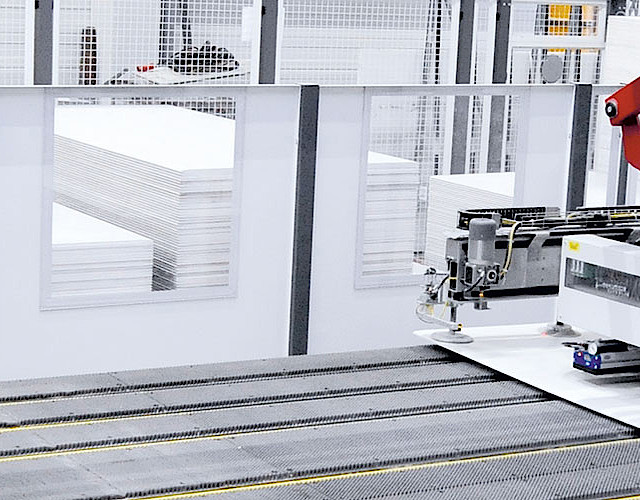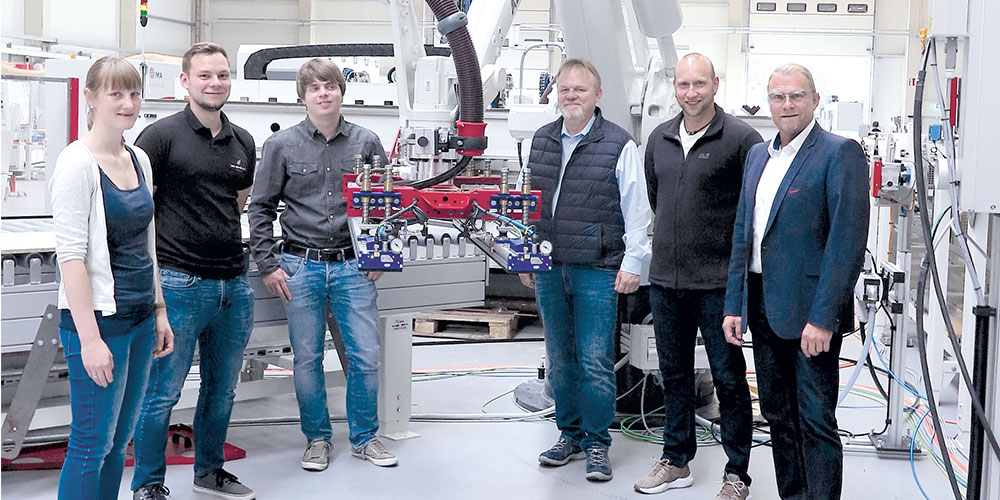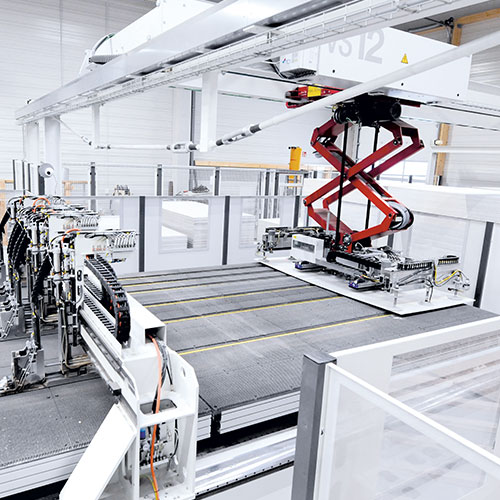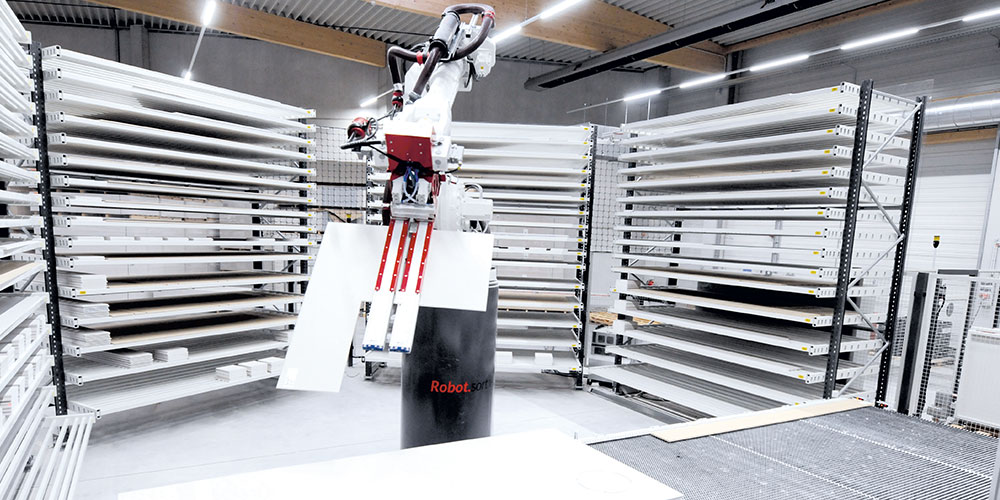
INTELLIGENT WORK CELL CONCEPT FOR TIMBER FRAME HOUSE PRODUCTION
FingerHaus, the renowned manufacturer of timber frame houses, has modernized the component production for its wall linings and now utilizes an extremely compact, fully automated panel cutting and component sorting cell from the IMA Schelling Group.
The prefabricated home specialist FingerHaus produces almost three and a half single-family houses per day. Each house consists of completely prefabricated wall components for quick assembly on the construction site. When the components leave the factory, windows, doors, cables, pipes and supply connections are already incorporated into them. The basis of the wall components are timber frame structures, lined with gypsum plasterboards, fermacell boards or chipboard panels. Cutting the panel into the individual components for the wall linings is an essential step in the wallboard production at FingerHaus. To increase the efficiency of this step and at the same time make it easier for the staff to do their work, FingerHaus invested in a comprehensive modernization of its wallboard production. It was the IMA Schelling Group that designed and implemented the highly modern, fully automated workcell for panel storage, order picking and sorting of components.
In this process, a number of challenges had to be faced. One of the demands placed on the workcell was that the panel cutting operation was intended not only to perform square cuts but also oblique cuts and interior cutouts for connectors. In addition to that, the process was expected to minimize offcuts. “The most complex task was, however, to stack the different sized and different shaped panel components in the order of their further processing and as tight as possible,” explains Dirk Niebur from the project management at IMA Schelling. He and his colleagues solved the challenges with a raw panel storage system equipped with a fast storage conveyor system and additional storing and picking positions, a Performance.cut for panel cutting with downstream automatic label application and a robot-assisted Robot.sort v sorting cell for storing the components after the panel cutting operation and for stacking them in the order of their further processing. With the IPC.NET plant control system with stock management, IMA Schelling also provided the manufacturing execution system for the whole process.


INNOVATIVE PANEL CUTTING
The possibility to make all the cuts required for the production of the contour parts – without sacrifice material, in a single milling operation – is one of the numerous innovations of the FingerHaus project. For the interior machining, such as the milling of the interior cutouts for power sockets or wall connectors, both router spindles operate in tandem mode. "One of the big challenges in this project was to formalize the complexity of the various cuts and specifically the interior machining using algorithms,” Dirk Niebur says.
By the way, the dust typically produced in the milling process is perfectly extracted by the high-performance dust extraction system of the Performance.cut. Residual parts are automatically taken out of the cell, and waste parts are separated into gypsum plasterboard, fermacell board or chipboard.
THE HIGHLIGHT: ROBOTIZED SORTING OF PARTS – COMPLEX STACKING MADE EASY
The perhaps most important innovation, which also frees the FingerHaus staff from time-consuming and annoying work, is the robot-assisted Robot.sort v sorting cell. The link between order picking and panel cutting consists of an ABB shelf mounted robot of the IRB 6650S type and a storage rack system acting as a buffer between panel cutting and further processing. The robot, which has a particularly large working envelope and a high load carrying capacity, picks up the labelled sized components (wallboards) and buffers them chaotically in the storage racks. Then it stacks large batches of wallboards on pallets, where the order of boards stacked on a pallet corresponds with the order of their further processing. In order to be able to securely transport the sized components, IMA Schelling has equipped the robot with a special vacuum scissor gripper. The gripper reliably picks up the individual board materials and even large boards with dimensions up to 3200 mm x 1300 mm. In this process, an integrated fully automatic cleaning system constantly ensures proper operation of the vacuum pick-up device.
To stabilize the stacks of pre-sorted wallboards, the system uses filler parts. These parts are automatically generated by the panel cutting cell and placed in the critical positions in the board stack. The production capacity of the panel cutting and order picking cell, which FingerHaus operates in two-shifts, is approx. 600 parts per shift. Further processing of the wall components is then carried out in two-shift operation.
FLEXIBLE PROCESS CONTROL SYSTEM
Robot control is carried out via the IPC.NET plant control system with stock management and algorithms developed specifically for this purpose. To do so the experts of IMA Shelling programmed an intelligent IPC.NET interface to the robot that provides interaction of five different programming levels. The universal and open interface allows dynamic data transfer. This enables an infinite number of stacking solutions and flexible order processing - also in the future. With the help of the process control system, FingerHaus can adjust the workcell to new materials or component designs fast and simply, i.e. without much programming work. In the event of malfunction, almost all operating functions can also be controlled from the supervisory level. In this process, the operator has only one HMI for all elements to be controlled. „The people who work in the cell feel that the robot system is a great help and like working with it. They were trained by IMA Schelling in all basic functions relevant to us so that they do very well at using the robot operating functions,” says Marc Fischer, project supervisor at FingerHaus.

CONCLUSION
Due to the automation of panel storage, panel cutting and order picking for the wall fabrication, FingerHaus not only significantly increased the cost-effectiveness of the plant. The new solution also allowed them to substantially increase process, product and workplace quality. Marc Fischer was full of praise for the “excellent and always professional cooperation”: The IMA Schelling team can be proud of the work it has done and definitely say it has brought an absolutely innovative project in the prefabricated house industry into being. The workcell as a whole is running very well, and also fulfils the intended capacity objectives.”

ABOUT FINGERHAUS
With a construction of more than 700 houses per year, the prefabricated home specialist FingerHaus from Frankenberg (Eder) belongs to the top five companies in the industry and is represented with numerous sample houses and consulting offices all over Germany. No matter if bungalow, single family or multi family home – the company builds individualized dream houses and places high demands on quality and accuracy in the manufacturing & installation process.
FingerHaus, the renowned manufacturer of timber frame houses, has modernized the component production for its wall linings and now utilizes an extremely compact, fully automated panel cutting and component sorting cell from the IMA Schelling Group.
You can find more information about FingerHaus here: